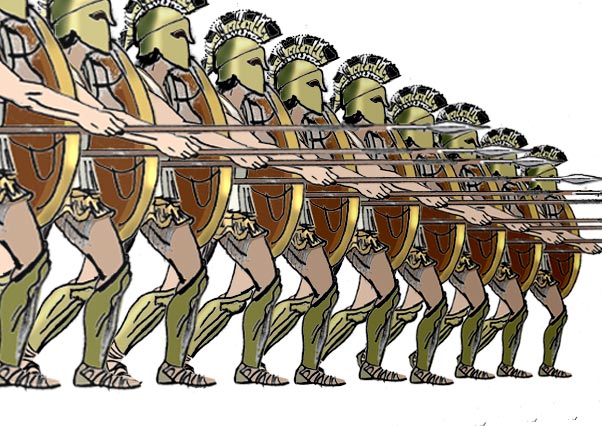In Warner Bros. epic film 300, the Spartan King Leonidas constantly reminds viewers of the power of free, citizen soldiers defending their lands and homes against the enslaved hordes of the Persian King Xerxes. Although the film’s historical accuracy is dubious at best, Leonidas is correct in his assessment of the strength of his Spartans. The Greek citizen-soldier hoplite was a revolution in ancient warfare.
A Greek hoplite was a heavily-armed infantryman. He was armored in a bronze breastplate, helmet, and greaves. On his left arm he supported a large, round shield that protected the left half of his body and the right half the man immediately to his left. In his right hand he wielded a spear some six to eight feet long. As a unit, men were arranged in a phalanx formation—a set of closely packed ranks, usually eight men deep. In combat, the front ranks interlocked their shields to form a protective wall, while those behind them thrust with their spears. The phalanx advanced in close formation and discipline was everything; a man charging forward in bravery and a man retreating in cowardice were both detrimental to a unit.

Greek hoplites in phalanx formation. From Wikepedia, "Phalanx Formation"
The use of hoplite tactics dramatically changed warfare in the ancient world. Previously, warfare had primarily been the domain of the aristocratic elite who could afford the necessary equipment. Nobles fought one-another in single combat and skirmishes, as depicted in Homer’s Iliad. As the elites were the ones to engage in warfare, the glory and spoils went to them and thereby enhanced their status. Moreover, as the elites possessed the weapons, they were well-positioned to maintain their status. With the development of the hoplite phalanx, war was no longer merely an act to accrue honor and loot; it became a matter of defending one’s land and livelihood. Moreover, warfare became more egalitarian. Officers fought and died within the ranks. Champions no longer existed. Victory depended on a collective effort that required the trust and cooperation of many.
A necessary precursor to the development of hoplite warfare was an emerging middle class. Each soldier had to provide his own equipment, and so a relatively wealthy population was required to amass the numbers necessary for phalanx formations. Early Greek city states were relatively poor, owning to mediocre soils and a crowded population. To relieve population pressure, the Greeks founded colonies. These colonies supplied their mother cities with raw materials, which fueled the emergence of craftsmen. Additionally, by reducing overcrowding, colonies increased the wealth of free farmers. These two groups formed the core of an emerging middle class. By around the seventh century B.C.E., this class could provide the armed men needed for phalanx formations, which were devastatingly effective against poorly disciplined enemies. Victories in war then opened up new lands to colonization and provided for the security of those already established. This created more wealth, which allowed for more hoplites, which conquered more territory in a feedback loop.
Another cultural prerequisite for hoplite warfare was an organized state apparatus to enforce military service. Previously in ancient Greece, war-parties were recruited from kinsmen, neighbors, and friends. The scale of hoplite warfare necessitated that all able-bodied and fully-equipped men participate when fighting began. To do this, societal institutions had to stigmatize and punish those who dodged military service. Athenian laws against refusing service may go as far back as 600 B.C.E. In Sparta, “Tremblers”—men who refused to go to war—could lose their rights as citizens. Men who had displayed cowardice in battle were unable to hold public office or obtain justice for insult or injury. “Tremblers” could not enter into contracts with other Spartans, nor would they be permitted to marry. While these punishments may seem severe, they were necessary realities of the age. Prior to hoplite warfare, a man who ran was merely a coward, but as hoplite tactics depended on an unbroken line of shields for defense, a man who ran was a direct threat to the survival of his comrades. Spartan mothers were said to have told their sons who were about to head off to war, “come back with your shield, or on it.”
References
W. G. Runciman. “Greek Hoplites, Warrior Culture, and Indirect Bias.”The Journal of the Royal Anthropological Institute, Vol. 4, No. 4. (Dec., 1998), pp. 731-751.
Chris Butler. “The Rise of Greek Democracy (c.750-500 BCE)” (Accessed 3/9/2007 ).
Phillip De Souza. The Greeks at War: From Athens to Alexander. (Accessed 3/9/2007)